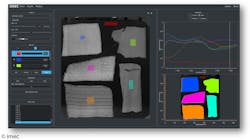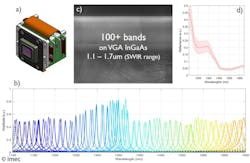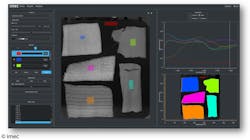imec demonstrates SWIR hyperspectral imaging camera
San Francisco, CA. imec today announced that it will demonstrate its very first shortwave infrared (SWIR) range hyperspectral imaging camera at next week’s SPIE Photonics West in San Francisco. The SWIR range provides discriminatory information on all kinds of materials, paving the way to hyperspectral imaging applications in food sorting, waste management, machine vision, precision agriculture, and medical diagnostics. imec’s SWIR camera integrates CMOS-based spectral filters together with InGaAs-based imagers, thus combining the compact and low-cost capabilities of CMOS technology with the spectral range of InGaAs.
Semiconductor CMOS-based hyperspectral imaging filters, as designed and manufactured by imec for the past five years, have been utilized in a manner where they are integrated monolithically onto silicon-based CMOS image sensors, which has a sensitivity range from the 400- to 1,000-nm visible and near-IR (VNIR) range. However, it is expected that more than half of commercial multi and hyperspectral imaging applications need discriminative spectral data in the 1000- to 1,700-nm SWIR range.
“SWIR range is key for hyperspectral imaging as it provides extremely valuable quantitative information about water, fatness, lipid, and protein content of organic and inorganic matters like food, plants, human tissues, pharmaceutical powders, as well as key discriminatory characteristics about plastics, paper, wood, and many other material properties,” commented Andy Lambrechts, program manager for integrated imaging activities at imec. “It was a natural evolution for imec to extend its offering into the SWIR range while leveraging its core capabilities in optical filter design and manufacturing, as well as its growing expertise in designing compact, low-cost, and robust hyperspectral imaging system solutions to ensure this complex technology delivers on its promises.”
imec’s initial SWIR range hyperspectral imaging cameras feature both linescan “stepped filter” designs with 32 to 100 or more spectral bands, as well as snapshot mosaic solutions enabling the capture of 4 to 16 bands in real-time at video-rate speeds. Cameras with both USB 3.0 and GIGE interface are currently in the field undergoing qualification with strategic partners.
“The InGaAs imager industry is at a turning point,” explained Jerome Baron, business development manager of integrated imaging and vision systems at imec. “As the market recognizes the numerous applications of SWIR-range hyperspectral imaging cameras beyond its traditional military, remote sensing, and scientific niche fields, the time is right for organizations such as imec to enable compact, robust, and low-cost hyperspectral imaging cameras in the SWIR range, too. Imec’s objectives will be to advance this offering among the most price sensitive volume markets for this technology, which include food sorting, waste management and recycling, industrial machine vision, precision agriculture, and medical diagnostics.”
The first SWIR range hyperspectral imaging cameras will be demonstrated through February 1 at SPIE Photonics West in San Francisco.


